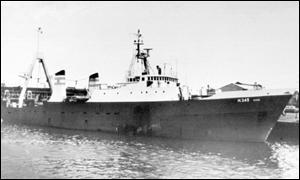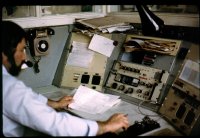|
MARITIME Wick Radio
|
DISTRESS WATCH The listening watch for those in trouble at sea (and sometimes elsewhere) was, for the people who staffed Coast Radio Stations, their most important reason for being there. They might spend most of their time connecting telephone and telex calls or taking and sending telegrams, but their ears were always "tuned" for the all important SOS/MAYDAY, XXX/PAN, TTT/SECURITY - these "tunes" could override anything else they were involved in. The strategic postion of GKR, covering a vaste area and some very inhospitable waters, resulted in the station being involved in many cases of casualty working, from it's very early years to the present day (even though the station is no longer officially on distress watch) GKR's presence has been a vital link to those in peril and many lives have been saved although, unfortunately, not all Distress operations end successfully. Brian Faulkner's book "Watchers of the Waves", in it's chapter about Wick Radio, records some of the distress incidents the station had been involved in - Darpen in 1921, towed to safety - Blue Crusader in 1965, lost without trace - Opal in 1970, towed to safety BUT, the rescue process resulting in the capsize of the Fraserburgh Lifeboat with loss of four lives - Piper Alpha in 1988, a major distress incident with over 12 hours of highly active casualty working and massive loss of life. Because of heavy consentration of fishing vessels in the waters watched by GKR, the station's transmitters had the unusual addition of the frequency 2226kHz. This was the primary fishing vessel intership frequency - and most fishing vessels preferred to monitor their pals rather than listen on the 2182kHz Distress frequency. When required, one quick call on 2226 soon brought them up to listen to GKR's broadcasts. Fishing Vessels had their own way of reacting to their own errors of navigation. One vessel called GKR for a telephone call during which he reported that he had run aground on the Orkneys. Did he require any assistance? No, no - he'd just wait for the next tide and float off! Another fishing vessel called GKR on 2182kHz with a MAYDAY call. Immediately he was answered. What's the problem? Nothing! He'd been told that he hadn't a hope of getting a telephone call through Wick unless he was in Distress. He pretty soon got the message that steam was coming out of GKR's hair!!!!!! Some Distress incidents happened almost on GKR's doorstep - the fishing vessel Trident lost with all hands when she was steaming off Wick, overwhelmed with such speed that the skipper had no time even to reach for the radio - a light aircraft flying from Inverness arrived at Wick to find the airport fogged in his fuel fast running out; it could have resulted in a ditching but, sadly, it ended in a failed attempt at landing and loss of the pilot's life when the plane ploughed into a dyke. The Pentland Firth, where tankers could steam at full speed and still be pushed back by the tides and currents, has claimed many ships over the years. But it has also seen some daring and successful rescues by Lifeboat and helicopter crews. Following one successful rescue, after running onto the Orkneys during a storm, the Captain of the stricken ship told the Scottish Sunday Express "We knew we would be okay when the Wick Radio answered my Mayday call". Sometimes incidents were almost inexplicable, like the beautiful sunny summers day when there wasn't a breath of wind and visibility was just perfect - and two cargo ships managed to collide just due east of Wick. An open 2182 transmitter let us hear the ships emergency siren and the chaos on board! One vessel was able to continue it's voyage, it's bow damaged but intact - the other made for Wick harbour where the locals were able to witness the damage, a large V-shaped midships gap! Towards the end of a busy evening shift a rapid Mayday call in French was heard. Coast Station Radio Officers have a smattering of French, but it's certainly far from fluent. A very rough translation appeared to suggest a position west of the Hebrides but the call was quickly answered by St Nazaire Radio in France. A short exchange of information between St Nazair and the ship and then a MAYDAY RELAY from St Nazaire which confirmed the ships position, as thought, west of the Hebrides and on fire. Alerting UK fishing vessels in the area and using the powerful 4000 watt transmitter GKR joined in the action. Distress activity means everyone not involved keeps quiet. In this case, with communications taking place between Wick, St. Nazaire and the Rockall area, the whole of Europe was in silence! The evening shift stayed on until midnight to complete the working - another successful rescue and an excellent example of professional Radio Officers at work, cooperating and coordinating regardless of language. At the end of distress working a coast station broadcasts the signal Seelonce Fini, to indicate that the distress is over and normal working can resume on the distress frequency. But at the coordinating Coast Radio Station the next phase of the work was just beginning. Unknown to those listening to the Distress action, a detailed written log was being maintained throughout the incident. This log and all messages related to the incident must now be impecably typed up into a formal Casualty log. If required, the log will be certified as a true copy and can be produced as evidence in any formal enquiry, investigation into the incident or similar proceedings. Sadly, money became and overriding factor in the provision of the maritime distress watch. With the Coastguard being turned into a government agency and being made to pay for all such services from a restricted budget, it was deemed suitable that the distress watch could be maintained by the staff of the Coastguard service, most of them amateurs (with a small "a") in the skills of radio operating, using lower powered ship-type radiotelephone transceivers with limited antenna systems. So, at the end of June 1996, the UK Coast Radio Stations came off 2182kHz distress watch. This was followed at midnight on 31st January 1997 with the cessation of the 500kHz distress watch. The end of the UK's professional distress watch service for mariners.
|

 GKR's unique link with the distant fishing fleet saw the station involved
in remote distress incidents on numerous occasions. If a trawler failed
to make a regular report within a given time period it was over to Wick
to try to find out why. Sometimes the answer was simple - bad radio
conditions or a failed transmitter. Sometimes the outcome was much sadder
- wreckage found or, such as in the case of the trawler
GKR's unique link with the distant fishing fleet saw the station involved
in remote distress incidents on numerous occasions. If a trawler failed
to make a regular report within a given time period it was over to Wick
to try to find out why. Sometimes the answer was simple - bad radio
conditions or a failed transmitter. Sometimes the outcome was much sadder
- wreckage found or, such as in the case of the trawler  Another
strange incident was an SOS received on 500kHz from a Soviet vessel.
The vessel was between Shetland and the Faeroe Islands and in the area
normally controlled by Thorshaven Radio/OXJ. OXJ answered the SOS several
times but all he got was a repeat of the message. So GKR called - with
the same result. Then Rogaland Radio/LGQ in Norway and Reykjavic Radio/TFA
in Iceland had a go. The signals went on for hours - so much so that
newspapers had time to charter aircraft and to take pictures of the
striken vessel which revealed her to be well ablaze. In these Cold War
times it was not politic for the Soviet Captain to seek aid from the
west, so he had advised his problem through his own channels and sought
assistance from his own type. By the time he was forced to use the conventional
means of seeking rescue the situation had moved well beyond sitting
in a Radio Room comunicating. Although all Radio Officers were well
aware that ship's had automatic means of sending such distress calls,
what we didn't realise was that on Soviet ships this facility was activated
from the Bridge and included the ability to input the ship's position
- it put our technology a bit in the shade! And his actions were ultimately
successful - another Soviet ship eventually arrived on the scene, rescued
the crew and took the blazing vessel in tow.
Another
strange incident was an SOS received on 500kHz from a Soviet vessel.
The vessel was between Shetland and the Faeroe Islands and in the area
normally controlled by Thorshaven Radio/OXJ. OXJ answered the SOS several
times but all he got was a repeat of the message. So GKR called - with
the same result. Then Rogaland Radio/LGQ in Norway and Reykjavic Radio/TFA
in Iceland had a go. The signals went on for hours - so much so that
newspapers had time to charter aircraft and to take pictures of the
striken vessel which revealed her to be well ablaze. In these Cold War
times it was not politic for the Soviet Captain to seek aid from the
west, so he had advised his problem through his own channels and sought
assistance from his own type. By the time he was forced to use the conventional
means of seeking rescue the situation had moved well beyond sitting
in a Radio Room comunicating. Although all Radio Officers were well
aware that ship's had automatic means of sending such distress calls,
what we didn't realise was that on Soviet ships this facility was activated
from the Bridge and included the ability to input the ship's position
- it put our technology a bit in the shade! And his actions were ultimately
successful - another Soviet ship eventually arrived on the scene, rescued
the crew and took the blazing vessel in tow.